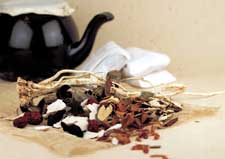Magazine
High Tea

Humble to haute, Chai is no longer just your mother's cup of tea.
|
A cup of chai at your neighborhood café could give you sticker shock: $3 or more for the humblest cup. We South Asians know our chai, but the variety at tea shops differs markedly from the homemade. Often sweetened with non-traditional flavors like vanilla and cinnamon, an endless variety of new chai flavors are showing up all over the country. Coast to coast, chai is becoming a staple beverage, accompanying coffee menus.
New York City’s Tavalon Tea Bar, co-founded by Sonny Caberwal with John-Paul Lee, is one of an estimated 1,500 specialty tea shops and retail tea outlets nationwide that are turning tea hip. A former attorney, Caberwal realized early in his legal career that he would be happiest working in an environment that combined his twin loves of music – he is an accomplished tabla player – and tea. This vision created Tavalon, a sleek café, whose gleaming white interior and music booth where notable DJ’s regularly spin music, showcase the brand’s many custom-blended teas. “We are both big tea drinkers and wanted to create a space around a brand of really high quality, healthy tea that was still accessible to people who might not traditionally drink tea,” Caberwal says. Tavalon currently has over 50 different varieties of unique teas that are grown all over the world, which Caberwal acknowledges can be intimidating for novice tea drinkers. “Part of our goal at Tavalon is to train customers to smell, touch and taste the tea so that they can learn about the many types of tea and feel comfortable trying new varieties,” Caberwal says. To accomplish this, test tubes filled with each of Tavalon’s loose-leaf teas are assembled at the entrance of the store where customers are encouraged to become personally familiar with varieties. Tavalon even employs a “tea sommelier” to help drinkers find the most satisfying cup. Despite Tavalon’s many tea blends and the striking absence of the exotic South Asian decor that many other tea stores employ to create ambiance, Caberwal nonetheless notes that Tavalon’s most popular blend of tea is, of course, chai. As growing numbers of independent tea shops like Tavalon pop up across the country, it is no surprise that the country’s largest coffee chain Starbucks too has entered the act. According to Lisa Passe, representative of Starbuck’s Global Brand Strategy Department, Starbucks began offering its version, dubbed “Tazo Chai”, in 1997. Starbucks’ chai has steadily increased in popularity and the chai latte now ranks as the company’s second most popular latte drink sold nationally. The east and west coasts, and interestingly Colorado, lead sales. Passe cites two reasons for chai tea’s popularity at Starbucks. First, Starbucks’ chai mixes the exotic with the familiar. Its recipe blends five spices that have been commonly used in chai across India for decades: ginger, cardamom, star anise, cloves and cinnamon. The blend is a “classic masala chai,” Passe says, whose recipe has been perfected across India. “Roadside tea merchants called chai wallahs have been serving the combination of black tea and exotic spices, prepared on open stoves with milk long before lattes,” she says. “One can see this ceremony repeated throughout towns, cities, and the countryside of India, and in railway stations, open air markets, and villages.” Building on this tried and tested true formula, Starbucks’ recipe adds sweetness and familiarity for the western palette with honey, organic cane sugar and a hint of vanilla. Another reason, Passe says, chai has become popular at Starbucks hreflects the general philosophy of tea drinkers and vendors alike: tea has health benefits. In today’s marketplace, consumers are increasingly conscious of personal health with a focus on what they eat and drink. It is no surprise then that chai has increased in popularity as tea’s general health benefits are being touted nationwide. While the jury is still out on whether daily cups of coffee help consumers, tea is perceived – and marketed – as a healthy hot drink alternative. “Customers are becoming more aware of the many health benefits associated with drinking tea,” Passe says, and “chai combines the foamy creaminess people love with their lattes, but with all of the goodness of tea.” But what are the health benefits of tea? Tavalon’s various teas cite a long list of health benefits, including the lowering of blood pressure associated with black tea consumption and aiding of weight loss with white tea. Black and white varieties of tea were found to have fewer benefits than their green tea counterpart, although all varieties of tea were thought to have positive health benefits. Though the benefits are still debatable, chai’s enormous popularity is indisputable. Evolving from Indian kitchens and roadside stands to swanky shops worldwide, chai has become the alternative drink of choice at the coffee shop.
|



 Although tea is now grown and enjoyed across India, tea leaves, derived from a plant known to botanists as Camellia sinensis, is not native to most of South Asia. The northeastern Indian state of Assam is the ancestral home to one wild strain of tea plant, with others varieties common to southern and eastern China and Myanmar. Although accounts vary as to who is responsible for India’s commercial tea production, the British established tea estates during the late 19th century after the first batch of Assam’s black tea popularly sold in London.
Although tea is now grown and enjoyed across India, tea leaves, derived from a plant known to botanists as Camellia sinensis, is not native to most of South Asia. The northeastern Indian state of Assam is the ancestral home to one wild strain of tea plant, with others varieties common to southern and eastern China and Myanmar. Although accounts vary as to who is responsible for India’s commercial tea production, the British established tea estates during the late 19th century after the first batch of Assam’s black tea popularly sold in London.
You must be logged in to post a comment Login